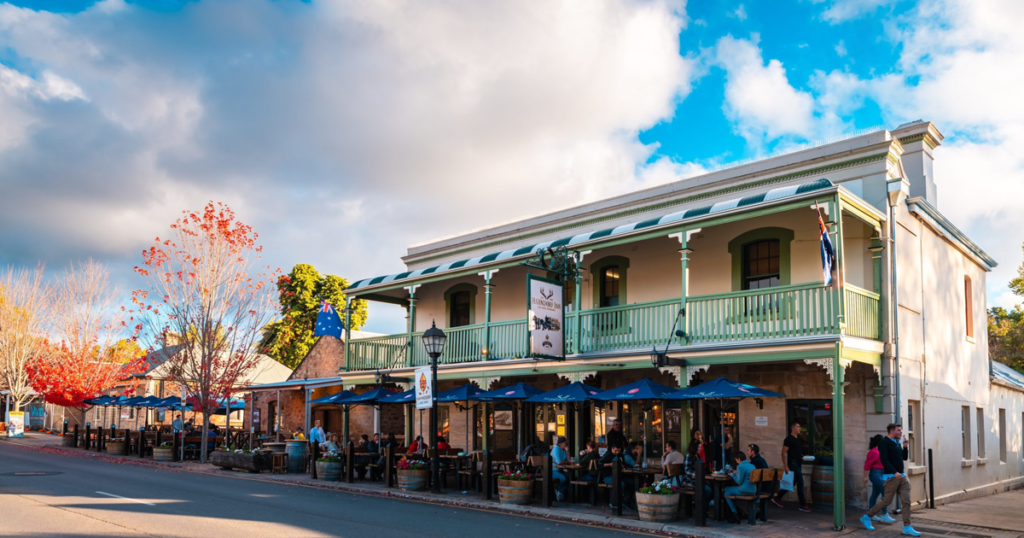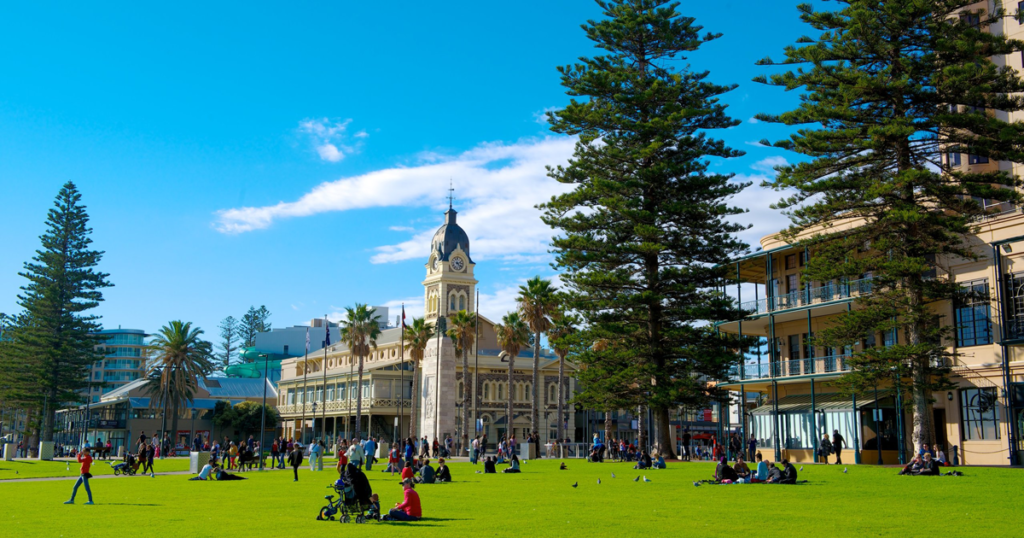Are you ready to explore the contrasting sizes of two iconic Australian cities? Strap in and prepare for a wild ride as we delve into the question: How big is Adelaide compared to Melbourne?
Prepare to be amazed by the sheer scale of these urban giants and discover the unique charms they each have to offer. From sprawling landscapes to bustling cityscapes, this article will take you on a journey through the dimensions of these metropolises.
Geographical Boundaries
It would be best to consider the geographical boundaries when comparing the sizes of Adelaide and Melbourne. The geographical boundaries play a significant role in shaping the size and development of cities.
Adelaide is located on the southern coast of Australia, surrounded by the Mount Lofty Ranges to the east and the Gulf St Vincent to the west. These natural features act as physical boundaries, limiting the city’s expansion.
On the other hand, Melbourne, situated on the southeastern coast, doesn’t face such constraints. It has a more expansive geographical area, allowing for more excellent city development. Melbourne benefits from a more giant landmass, enabling it to accommodate a larger population and infrastructure. This has contributed to Melbourne’s growth and prominence as Australia’s second-largest city.
In contrast, Adelaide’s smaller geographical area has influenced its development to be more compact. While both cities have unique characteristics and attractions, understanding the geographical boundaries is crucial when comparing their sizes and potential for growth.
Land Area Comparison
When comparing the land areas of Adelaide and Melbourne, it’s essential to consider factors such as geographical boundaries. Here are four key points to help you understand the comparison:
- Area: Adelaide covers an approximate land area of 1,826 square kilometres, while Melbourne spans a much larger area of around 9,990 square kilometres. Melbourne’s land area is more than five times Adelaide’s, making it significantly larger.
- Geographical Features: Adelaide is located on the coastal plain between the Mount Lofty Ranges and the Gulf St Vincent. It’s known for its beautiful beaches and rolling hills. In contrast, Melbourne is situated on the northern shore of Port Phillip Bay and is surrounded by flat plains. Melbourne is also home to the Yarra River, which adds to its scenic beauty.
- Urban Development: Adelaide has experienced steady urban growth and development, with a well-designed city layout and a mix of historic and modern architecture. Melbourne, on the other hand, has seen rapid urban development, particularly in recent years. It’s known for its vibrant cityscape, iconic landmarks, and diverse neighbourhoods.
- Future Prospects: Both cities have ambitious plans for future development. Adelaide aims further to enhance its livability, sustainability, and economic growth. As Australia’s fastest-growing city, Melbourne plans to accommodate its increasing population through strategic urban planning and infrastructure projects.
Population Size
Adelaide’s population has been steadily growing over the years, with an increase of 4.3% from 2016 to 2021.
In contrast, Melbourne has a much higher population density, with over 5 million residents.
These contrasting numbers highlight the difference in scale between the two cities and the varying levels of urbanization.
Adelaide Population Growth
Adelaide is experiencing rapid population growth. The city’s population has steadily increased over the past decade, with projections showing that it will continue to grow in the coming years. This growth can be attributed to several factors, including:
- Economic opportunities: Adelaide has seen a rise in job opportunities and economic development, attracting individuals and families to move to the city in search of better prospects.
- Lifestyle and livability: Adelaide is known for its high quality of life, affordable housing, good healthcare, and a strong sense of community. Many people are drawn to the city’s relaxed and laid-back lifestyle.
- Education and research: Adelaide is home to several prestigious universities and research institutions, making it an attractive destination for students and academics worldwide.
- Urban development: The city has been undergoing significant urban development, with new infrastructure projects and improvements to public transportation. This has made Adelaide a more attractive place to live and work.
Overall, the rapid population growth in Adelaide is a testament to the city’s appeal and potential for future development.
Melbourne Population Density
You’ll be surprised to know that Melbourne’s population density is over 5,000 people per square kilometre, making it one of Australia’s most densely populated cities. This high population density significantly impacts Melbourne’s urban planning and infrastructure development. The city must carefully manage resources and plan for sustainable growth to ensure its residents’ high quality of life.
On the other hand, Adelaide, a city on the southern coast of Australia, has a much lower population density. This difference in population density has led to varying housing market conditions between the two cities.
While Melbourne’s housing market is characterized by high demand and increased prices, Adelaide’s housing market offers more affordability and choices for potential buyers. Understanding these differences is crucial for individuals looking to relocate or invest in either city.
Cityscape and Architecture
You can often appreciate the cityscape and architecture while walking through Adelaide’s streets. The city’s rich history can be seen in its well-preserved historical landmarks and thoughtful city planning. Here are four things to help you enjoy Adelaide’s cityscape and architecture:
- Explore the Adelaide Oval: This iconic sports venue hosts cricket and Australian Rules Football matches and offers stunning views of the city skyline. Take a walk around the oval and admire its modern design.
- Visit the Adelaide Central Market: This bustling marketplace isn’t only a food lover’s paradise and a feast for the eyes. The market’s stunning architecture, Victorian-era facade, and vibrant atmosphere will transport you to a bygone era.
- Wander through North Terrace: This cultural boulevard is home to Adelaide’s most significant historical landmarks, including the State Library of South Australia, the Art Gallery of South Australia, and the South Australian Museum. Take your time to appreciate the grandeur of these buildings.
- Stroll along Rundle Mall: This pedestrian shopping precinct is known for its unique blend of modern architecture and heritage buildings. Take a leisurely walk along the mall and admire the mix of old and new.
By exploring these locations, you’ll have the opportunity to appreciate the city’s rich architectural heritage and stunning cityscape.
Enjoy your time in Adelaide!
Cultural Diversity
Cultural diversity is a crucial aspect of any city, and Adelaide is no exception. With its multicultural population, Adelaide is often referred to as a cultural melting pot, where people from different ethnic backgrounds coexist and contribute to the vibrant fabric of the city.
When discussing cultural diversity in Adelaide, it’s essential to consider the representation and influence of different ethnic communities in shaping the city’s social, economic, and artistic landscape.
Cultural Melting Pot
Don’t forget to embrace the city’s vibrant cultural melting pot during your visit. Adelaide is known for its diverse and multicultural community, offering a wide range of cultural experiences for everyone to enjoy. Here are four ways to immerse yourself in the city’s cultural exchange:
- Attend Multicultural Festivals: Adelaide hosts numerous multicultural festivals throughout the year, showcasing the traditions, music, dance, and cuisine of different cultures. From the Adelaide Festival of Arts to the OzAsia Festival, there’s always something happening to celebrate diversity.
- Explore Cultural Neighborhoods: Stroll Adelaide’s cultural neighbourhoods, such as Chinatown and Little Italy, where you can find authentic restaurants, shops, and cultural landmarks.
- Visit Museums and Galleries: Adelaide has various museums and galleries that highlight the city’s cultural heritage. From the South Australian Museum to the Art Gallery of South Australia, you can discover fascinating exhibits and artworks worldwide.
- Engage in Cultural Workshops: Participate in cultural workshops that offer hands-on experiences, such as cooking classes, traditional crafts, and language lessons. It’s a great way to learn about different cultures firsthand.
With its rich cultural tapestry, Adelaide invites you to embrace diversity and celebrate the city’s vibrant multiculturalism during your visit.
Ethnic Representation in Adelaide?
When discussing ethnic representation in Adelaide, it is essential to consider the diverse range of cultures and backgrounds that contribute to the city’s multicultural fabric. Adelaide is home to a rich tapestry of cultural traditions and immigrant communities that have shaped its identity over the years. To give you an idea of the city’s ethnic diversity, here is a snapshot of some of the prominent cultural groups in Adelaide:
| Cultural Group | Percentage | Contribution |
|---|---|---|
| English | 73% | Language |
| Italian | 4% | Cuisine |
| Chinese | 3% | Festivals |
These numbers only scratch the surface of the vibrant mix of cultures that thrive in Adelaide. From Greek to Vietnamese, Indian to Sudanese, the city is a melting pot of traditions, languages, and customs. This diversity enriches the city’s social fabric and offers opportunities for all residents to learn, grow, and celebrate together.
Economic Importance
It would be best if you considered these two cities’ economic importance before comparing. Adelaide and Melbourne are both significant financial hubs in Australia, contributing to the country’s overall economic growth. Here are four key factors to consider:
- Economic Growth: Both cities have experienced steady economic growth over the years. Melbourne, being the larger city, has a more diverse economy with solid sectors like finance, manufacturing, and IT. Adelaide, on the other hand, has a focus on defence, healthcare, and education sectors.
- Employment Opportunities: Melbourne offers many job opportunities due to its larger population and diverse industries. It’s known for its thriving arts and culture scene and its strong presence in the financial and professional services sector. Although ,more minor Adelaide offers employment opportunities in industries like defence manufacturing, health, and education.
- Industry Specialization: Melbourne has a broader range of industries, making it a more attractive destination for job seekers. Conversely, Adelaide has a strong focus on defence and advanced manufacturing, with significant defence contractors and research institutions located there.
- Cost of Living: Melbourne has a higher living cost than Adelaide. This could impact the affordability of housing, transportation, and other living expenses, making Adelaide a more cost-effective option for some individuals.
Both cities offer unique economic opportunities, and the choice between them depends on individual preferences and career goals.
Transportation Infrastructure
Several major highways and public transportation options are available in Adelaide and Melbourne. Regarding transportation accessibility, both cities offer a range of choices to help you get around.
Adelaide has a well-developed public transportation system consisting of buses, trains, and trams. The Adelaide Metro operates an extensive network covering most of the city and its suburbs. The system is known for its efficiency and reliability, making it easy to navigate and reach your destination.
Melbourne, on the other hand, boasts an extensive public transportation network as well. The city is serviced by trams, trains, and buses, all operated by Public Transport Victoria. The tram network is particularly notable, as it’s one of the largest in the world.
Regarding public transportation efficiency, both cities have made significant investments to ensure that commuters can travel smoothly and conveniently. Whether you’re in Adelaide or Melbourne, you can rely on the public transportation options available to explore the city with ease.
And Finally…
In conclusion, while Adelaide and Melbourne both have their own unique qualities, Melbourne stands out as the larger and more cosmopolitan city.
With its larger land area, higher population size, and diverse cityscape, Melbourne offers a bustling urban environment with a wide range of cultural activities and economic opportunities.
Its impressive transportation infrastructure further enhances its appeal.
So if you’re looking for a vibrant and dynamic city experience, Melbourne is the place to be.



